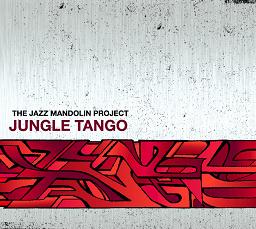 The Jazz Mandolin Project
The Jazz Mandolin Project
Jungle Tango
Lenapee Records
Review by Ted Silverman. ©2003, all rights reserved.
Kicking off with an aggressive bass line backed by
techno-trance drum beat, stabbing accordion lines and an ascending then
descending melodic motif, it is difficult to tell whether the title
track from the Jazz Mandolin's fourth album, Jungle Tango,
defines the meeting point between trance and tango or if it qualifies as
the soundtrack to some mysterious, high-speed, cinematic, Italian car
chase.
Jamie Masefield, accompanied by upright
bassist Danton Boller, drummer Ari Hoenig, percussionist Chris Lovejoy,
and Gil Goldstein on piano and accordion, have produced an intriguing
mélange of groove, swirl, funk, and jazz with the latest incarnation of
the Jazz Mandolin Project.
Track number 2, "Freddy,"
explores a deeper trance groove and the dissonance -invoking potential
of amplified mandolin. These sonic explorations aim for an Ozric
Tentacles modality and draw no direct link with any standing mandolin
tradition of the past. You won't find any affinity with David Grisman or
Paul Glasse here. Masefield's arrangements veer radically from any
mandolin-centered recording you have heard before.
Not until track 3, the funky and
meandering "At the Pershing," does any semblance of more
commonplace jazz voicing emerge from the binary code of this decidedly
futuristic-sounding CD. Gil Goldstein graces the track with the first
accessible and melodically resonant passages of the album-but before you
can say ahhh, the groove and beat replace the plangent explorations of
the piano. The JMP's jazz is beat-centric and not particularly concerned
with melodic themes. This is not to say that the songs aren't catchy nor
that the chops are lacking, it just takes a long time to get oriented to
the focus of the ideas herein. The kinds of sounds associated with
mandolin and piano seem to be deeply buried or bookended by layers of
bass and drum groove.
Masefield's instrument is for the most
part heavily processed, relying on digital reverb, feedback, distortion
and chorus for expression. In this sense one could consider the bulk of
the recording to showcase an inorganic use of the mandolin, but the
tunes move along with an easy grace and the kind of sonic trickery that
is fun to deconstruct with repeated listening.
Masefield's strength seems to be more in
the control and manipulation of intriguing tones than in having the sort
of monster melodic chops that put guys like Grisman, Thile, Marshall,
and Paul Glasse on the mandolin map. He can play some wild passages, but
they lack the wow factor associated with those who can awe an audience
without resorting to electronic trickery. There is also a decided
avoidance of blues or roots arrangements. Chordal washes, rhythmic
accents and bass-heavy groove mining take precedence over melodic
extrapolations.
Late in the game with track 7,
"Reich's Boogie," the CD seems to live up to the expectations
that define the term "Jazz Mandolin." But repetitive ostinatos
over drum'n'bass underpinnings dominate even when familiar tones
surface. And even later with track 9, "There's a Pipe in the
Cellar," full throttle industrial beats define the groove.
All things considered, Jungle Tango
is an intriguing sonic amalgam that bares repeated listening and offers
pulsing, contemporary grooves and psychedelic tonalities. Perfect for
late night mood enhancement, but not the kind of record to spin for
sunny day happiness inducement. Masefield continues to employ the
mandolin as a sonic toolbox, generally avoiding the inherent tonal
palette of the instrument. Jungle Tango is an interesting sonic
experiment on par with music from the likes of Bill Frisell, the late
James T. Kirk, and Medeski, Martin, and Wood. Don't seek it out if you
long for Tiny Moore or Jethro Burns.
Overall: ![]()
![]()
![]()
![]() Emando
content:
Emando
content: ![]()
![]()
![]()
![]()
![]()